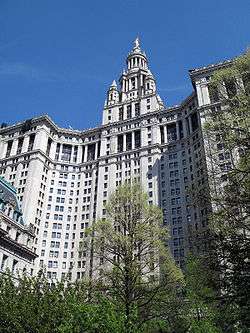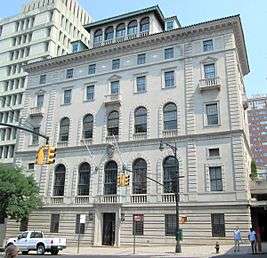William M. Kendall



William Mitchell Kendall (13 February 1856 – 8 August 1941) was an American architect who spent his architectural career with the New York firm McKim, Mead & White, from 1882 until his death in 1941. The leading American architectural practice at the turn of the century, McKim, Mead & White was renowned for its classical and Renaissance Revival work; dozens of prominent architects began their careers at McKim, Mead & White. Kendall was closely associated with partner Charles Follen McKim and added a refined delicacy to McKim’s somewhat severe Roman classicism.[1]
Education and career
Born in Jamaica Plain, Massachusetts, Kendall received his undergraduate degree from Harvard University in 1876, studied at the Massachusetts Institute of Technology (MIT) from 1876 to 1878, and completed a year of travel and study in France and Italy. Kendall became a partner with McKim, Mead & White in 1906. He worked with McKim on many significant buildings, including the Morgan Library, the Low Memorial Library, and other buildings at Columbia University, the Washington Square Arch, Bellevue Hospital, and the Main Post Office (James Farley Post Office), all in New York City; Arlington Memorial Bridge, the Army War College, and the restoration of St. John’s Episcopal Church, in Washington, D.C.; the American Academy in Rome; and the Harvard University School of Business, many of the Harvard gates, and the Plymouth Rock Memorial (Pilgrim Memorial State Park), in Massachusetts. Kendall proposed inscribing the quotation from Herodotus on the frieze of the New York Post Office: “Neither snow nor rain nor heat nor gloom of night stays these couriers from the swift completion of their appointed rounds.”[2]
After World War I Kendall was a member of the Committee for the Beautification of Permanent American Military Cemeteries in France and England, traveling with a group from the U.S. Commission of Fine Arts to inspect proposed sites and recommend treatments for permanent American war cemeteries in Europe. He designed war memorials at several of the cemeteries.
Memberships and associations
Kendall was a member of the National Institute of Arts and Letters and was elected to the American Academy of Arts and Letters; served as a trustee of the American Academy in Rome; was a member of the Society of Mayflower Descendants; and served on the 1934 Prix de Rome jury with architects Louis Ayres and John Russell Pope. He was a fellow of the American Institute of Architects (AIA) and was honored with a merit award from the New York Chapter of the AIA in 1929. Kendall served on the U.S. Commission of Fine Arts from 1916 to 1921, and was a member of the Century Association and University Club in New York.[2]
References
Notes
- ↑ Wilson, R.G. (1983). McKim, Mead & White : architects. New York, N.Y.: Rizzoli. ISBN 0847804917.
- 1 2 “William Mitchell Kendall,” obituary “Annual Report of the Maria Mitchell Association,” vol. 40 (1941): 10.
Bibliography
- Luebke, Thomas E. (2013). Civic art : a centennial history of the U.S. Commission of Fine Arts. Washington, D.C.: U.S. Commission of Fine Arts. p. Appendix B. ISBN 0160897025.
- Roth, Leland M. (1985). McKim, Mead & White, architects. New York: Harper & Row. ISBN 0064301362.
External links
 Media related to William M. Kendall at Wikimedia Commons
Media related to William M. Kendall at Wikimedia Commons
